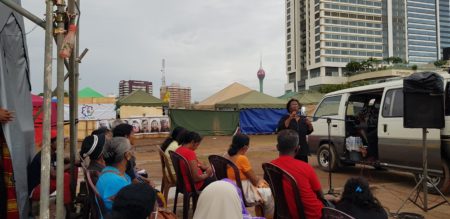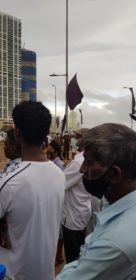“1971 was for a few months. 89 for more than two years, and the war? The war went on for 30 years…10,000 in 1971, 60,000 in 1989 and in the war, of those that entered 147,660 never came out alive.”
The intensity of Brito Fernando’s voice mirrors the intensity of the escalating violence he speaks of, as he traces Sri Lanka’s violent history of insurgency.
“The youth that took up the armed struggle in the North didn’t wear a cyanide capsule around their necks for the fun of it,” he reminds the gathering crowd. “They did so because they did not want to face the prospect of living in a country that had no future for them. They wanted a new state where they could be free,” Fernando reiterates.
“The issue was they took arms and they resorted to violence to match that of the state.”
Suddenly, his voice lulls.
“There’s a difference this time, friends. The youth of today have taken up the call GotaGoHome. There’s no violence here. There is only love.”
Brito Fernando, Chairman of the Families of the Disappeared, often repeats himself when he speaks in between the memories, recollections and stories shared by loved ones of the disappeared. He then provides an interlude to Jayathilaka Bandara’s singing that draws in enthused bystanders to the tent of the disappeared at GotaGoGama. The recurring points he more or less touches on are:
1.The GotaGoHome movement is a watershed moment in the history of Sri Lanka.
2. Every twenty years or so there has been an uprising by the youth of this country.
3. Each time it has been violently put down by the state.
These are calls to reform the state, to make it equitable, harmonious and prosperous for its people, but each time the state enforces violence to combat this and effectively stamps out any possibility for internal reform. Each time a generation of youth is wiped out; broad strokes of violence that have defined the late 20th and 21st century in Sri Lanka. The families of the disappeared are reminders, reliving the pain of a collective history that can’t be closed like a chapter in a book.
At the Families of the Disappeared programme at GotaGoGama on May 29, these sensibilities are reflected in Brito Fernando’s rousing speeches that seamlessly marry the humanistic themes of Bandara’s music and the heart wrenching testimonies of the families and loved ones of the disappeared.
Underneath all of this is the same call for systemic change and justice and accountability for the wrongs of the past. On that count, it’s done within the spirit of the aragalaya. The crux of GotaGo – the struggle of love.
It is an uneasy union. One that is nevertheless maintained by both the families of the disappeared at GotaGoGama and the organizers of the protest site. The onlookers and listeners here aren’t really an audience that have come to witness the testimony of the disappeared. Most are drawn in by Bandara’s music. The mothers that speak of their disappeared children say they see their children in the youth that are at the heart of the protest movement. They are here speaking out, reliving their lowest moments for all to see so that another generation of youth won’t go through what their children went through. Still, the vibrant youth of the movement aren’t really drawn to what’s happening here. Listeners are a hodgepodge of activists, human rights defenders, journalists and the one off passerby who pauses to listen for a moment or two. Throughout the evening, the crowd swells, burgeons and then dissipates. These are sensitive topics, ones that don’t sit well with the war hero narrative that many Sri Lankans still subscribe to. That the biggest benefactors of this narrative are now public enemy #1 is irrelevant. The sacrifices that achieved the ‘war victory’ still possess immense currency and standing within the average protester.
The struggle of love
The adare aragale (struggle of love) was true to its name on the gloomy Sunday evening. At GotaGoCollege was an elaborate presentation and discussion on the theme of love embodied in Bharatanatyam and its expression through colour. At the tent of the disappeared Jayathilake Bandara performs Gunadasa Kapuge’s Sinhala Sindhu Kiyana (The one who sings in Sinhala), a song based on the love between Tiger Police/Political Chief Balasingham Nadesan and his Sinhalese wife Vineetha; both executed by the army after surrendering in May 2009. Further on, at the gates of the Presidential Secretariat, more or less the heart of the protest site, a protester enthusiastically walks around the stage, asking the crowd, who the enemies of the struggle are. He points to the secretariat: “they’re in there!” he shouts, in great amusement.
“But, don’t think I mean the brothers in the uniform. They are on our side! This is the struggle of love and they are with us and they understand our struggle.”
Jennifer Weerasinghe would disagree. She addresses a smaller crowd just a couple hundred meters away at the Families of the Disappeared tent.

Weerasinghe is the mother of Dilan Jamaldeen, one of the youth abducted by the Navy during the extortion ring of 2008/2009. That the Navy perpetrated the abductions is well known to anyone familiar with the case. That the hierarchy of the Navy was at most involved and in the least complicit is beyond reasonable doubt. She informs the gathering that the Rajapksas and the Navy are intertwined. The boys were taken to the Trincomalee base, “I’ve seen the small room that they kept our boys,” Weerasinghe relates. “It was when they were there, that we last heard from them, but it is the same place that Mahinda Rajapksa took refuge after what he did here.”
“There is a huge deal the Rajapksas have with the Navy.”
Her disgust at the appointment of the former Navy Commander Admiral Wasantha Karannagoda to a committee to probe violent incidents is evident. The former Admiral was the 14th suspect named in the Navy 11 Case; the case brought against the disappearance of Jennifer’s son. Karannagoda was exonerated by the Attorney General in late 2021 and was subsequently appointed Governor of the North Central Province by Gotabaya Rajapaksa.
“What is he going to do in this committee? It is a disgrace. All he can do is lie. We are well aware of his lies,” says Weerasinghe.
She expands on the insult of Gotabaya Rajapksa’s Commission of Inquiry to Investigate Allegations of Political Victimization. “This government is so corrupt and heartless that they did not care about our suffering, the burden we have been carrying of wanting to know the truth of what happened to our children. They did not want to pursue justice, instead they kept trying to protect and save their own people by hiding their sins. They say they are political victims.”
In her rage she saves a few choice words for the extended Rajapaksa family.
After her, Brito Fernando repeatedly brings up the role of Gotabaya Rajapaksa in the spate of disappearances in the Matale district between May 1989 and January 1990 where he served as District Military Coordinating Officer. “Don’t forget Shavendra Silva was a company commander under the District Coordinator Gotabaya Rajapaksa,” Fernando says. There is deafening silence. It is General Silva’s final week as Army Commander.
Like development under the Rajapksas, the idea of a clean armed forces is a facade. One by one, the mothers with great difficulty share their stories. A mother from the South breaks down as she speaks of how her husband was taken away by a platoon leader in the Hambantota District in 1989. “My children pleaded with him. I was in the Middle East working at the time, they begged him and said that my husband was all they had. That was the last he was ever seen,” she manages to say through the tears and a wavering voice.
A short distance away, two policemen keep a wary eye on proceedings. There isn’t a great deal they can do in the current context. Whatever that’s said and done, the Families of the Disappeared here are within the GotaGoHome movement and at GotaGoGama. It has thus far defied the Rajapaksas and all their ploys and games and in the process dragged the Medamulana dynasty through the dirt. This could not have happened elsewhere obviously. Women’s collectives from the East who were at GotaGoGama in April told Groundviews that those protesting in the North and East aren’t even considered protesters. There is privilege here, that much is obvious.

Still this is the adare aragalaya. The combination of words I don’t recall were uttered during the programme organized by the Families of the Disappeared but it is love that keeps these parents going. Each time they break down, they seem to pause and then look within themselves to make sense of relating an immensely difficult event that has defined their lives to the audience. Most of them are reluctant, afraid, sometimes hopeless, but when they do build up the courage to open up all their words are molded and informed by the memory of their lost loved ones. Sri Lanka’s history with disappearances are often tied to the state apparatus and the armed forces; the same armed forces that are loved and adored by a large portion of the protesters at GotaGoGama.
Love is all around at GotaGoGama. And it’s quite the site to see, when it shines through the gloom — but just as there are different histories, narratives and beliefs that need to be reconciled with, it appears that even in love the struggle is yet to find common ground.
Families of the Disappeared held an event outside their tent at #GotaGoGama today. Families from the East who had made their way to Colombo also joined in the event. pic.twitter.com/J6ubbv1E8t
— Groundviews (@groundviews) May 29, 2022


